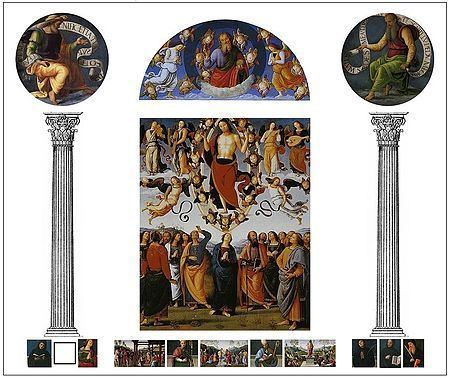Year c. 1496 – 1500 Location Various Created 1500 Genre Christian art | Medium Oil on panel Artist Pietro Perugino Period High Renaissance | |
 | ||
Pietro Perugino artwork Vallombrosa Altarpiece, The Ascension of Christ, Annunziata Polyptych, San Francesco al Prato R, Sansepolcro Altarpiece | ||
The San Pietro Polyptych (Italian: Polittico di San Pietro) is a polyptych by Italian Renaissance master Perugino, painted around 1496–1500. The panel are now in different locations: the lunette and the central panel, depicting the Ascension of Christ, are in the Museum of Fine Arts of Lyon, France.
Contents
Description
The polyptych had been originally commissioned for the Abbey of San Pietro at Perugia, the contract having been signed by Perugino on 8 March 1495. It included a large altarpiece and several panels, within a wooden frame by Domenico da Verona. The altarpiece, depicting the Ascension of Christ, was to have a lunette with the God in Glory between Angels above it, while the predella had not been exactly defined. The payment were 500 golden ducats, and no more than two years and a half were given to complete the work.
The panels were painted between January 1496 and the end of 1499, and the work was solemnly inaugurated on 13 January 1500. Contemporary art historian Giorgio Vasari considered the predella Perugino's best work in his home city.
In 1591 the church's choir was radically restored, and the altar had to be dismantled. After the religious suppressions of 1797, the work was acquired by the French, and was divided into several French museums, although several panels remained in Perugia or went to Papal collections in Rome.
Description
The cymatium was separated by the main panel by a frame, in the same way of the Vallombrosa Altarpiece. At the sides were two columns which supported the frame arch and which, at the bases, were decorated by three small panels with Saints, sharing the same background.
The polyptych included the following panels:
